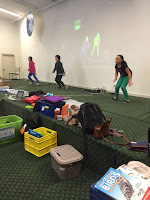 We considered these challenges carefully as we prepared to support our 45 learners to drive their own learning through their projects selected by them and planned by them (with varying degrees of help from us). We considered what Kath Murdoch had written as she challenged teachers to remember it's not only about the product at the end. So we thought about how we may get the learners planning their project - not only the project purpose, tools, experts and places that would support their learning, but how they would know if their learning was successful.
We considered these challenges carefully as we prepared to support our 45 learners to drive their own learning through their projects selected by them and planned by them (with varying degrees of help from us). We considered what Kath Murdoch had written as she challenged teachers to remember it's not only about the product at the end. So we thought about how we may get the learners planning their project - not only the project purpose, tools, experts and places that would support their learning, but how they would know if their learning was successful.As shared in an earlier blog post, we were thrilled with the variety of projects the students decided on, the experts they connected with, the trips they went on. As well as the practical things the students did, we were impressed with the active learner traits they demonstrated through their projects. Of course, this was the crux of Akoranga o Naenae: the opportunity to apply the skills of an active learner in a context that was meaningful and exciting for the learner.
Some examples of the traits we saw transferred:
Resilience: finding a different expert when one (or a few) didn't respond initially
Reflection: through blogs and slideshows about their learning process
Questioning: to find out what they really wanted to know about their passion.
 Connecting: with experts and places, each other, whanau, teachers. Working on projects when they weren't at AoN.
Connecting: with experts and places, each other, whanau, teachers. Working on projects when they weren't at AoN.Choosing: the tools to use, the places to go, how to share learning
Learning has purpose: making colouring in books for junior students, training junior rugby teams back at school, fundraising for endangered animals. Basically every project had to have a positive impact.

 On our last day, we had a very successful showcase, well attended by experts, teachers, principals and many, many whanau members. The most common thing we heard back was how confident the kids were talking about their learning. This makes sense as they had been instrumental in every aspect of their projects and we were thrilled as this had certainly been on our checklist of whether AoN had been successful.
On our last day, we had a very successful showcase, well attended by experts, teachers, principals and many, many whanau members. The most common thing we heard back was how confident the kids were talking about their learning. This makes sense as they had been instrumental in every aspect of their projects and we were thrilled as this had certainly been on our checklist of whether AoN had been successful.So what helped?
- Working with each of the students to plan their projects. We used this planning template, although we are currently streamlining how we blend this with learner maps and the slideshow. When they were stuck or wondering who to contact, this planning form reminded the students who they could connect with, as well as how to keep a positive mindset. It also got the students reflecting about their choices as the project was coming to a conclusion.
- We worked with many of the students to set their learning goals. We didn't get to all the kids and this is something we also want to streamline so it's on the slideshow of the project process.
- Getting students to make a slideshow of the project process. This really helped the students think about what they did and the impact of the choices on their learning. We will be introducing this at the start of the project process next round as it proved to be a great tool to support reflection.
- We placed the students into three groups with one of the teachers as their mentor. We put them with a teacher who had skills, knowledge or an interest in that area. Then we worked with those students at "Action" time (although some students roved between teachers and that was totally fine).
- We had some resources the students could go to when they didn't know who to look up, what search to use or what was a good site for something. One was a list of links. The other was a slideshow. This supported the learners to be independent when a teacher wasn't available to help them get to their next step.

With many of our learners being priority learners, and many of the projects being so specific, it was at times a task to give the students the help they needed to get to where they wanted to go but not over scaffold them. Many became more confident as they went on, and often sought out other students for support rather than teachers.
 It wasn't always easy or smooth, as chasing marbles rarely is. However, the outcomes were what we had hoped and planned for:
It wasn't always easy or smooth, as chasing marbles rarely is. However, the outcomes were what we had hoped and planned for:*Transference of active learning skills
*Engaged and motivated learners
*Community & whanau engagement in learning
*Personalised learning opportunities
*Purposeful lateral learning
And man, it was FUN.

No comments:
Post a Comment